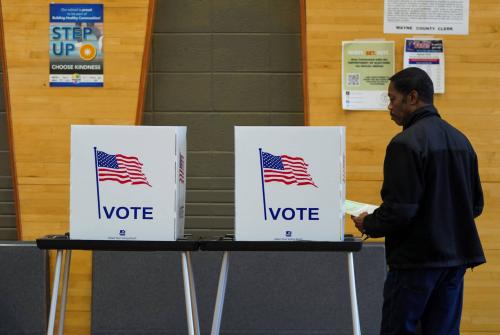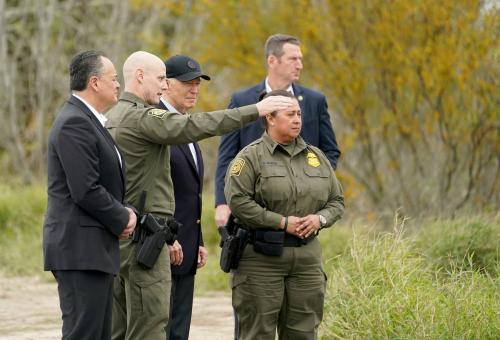It’s February 24, 2022.
President Biden steps to a flag-flanked podium with presidential seal at the White House. He speaks at length from a teleprompter in measured language reflecting his 40 years of statesmanship, then takes questions from journalists who challenge him and filter his remarks in their coverage.
In contrast, Volodymyr Zelensky, informal in a T-shirt on the streets of Kyiv with his lieutenants, posts a 40-second video: “We are still here. Our soldiers are here. We are all here.”
He rebuffs safe passage offered by the United States, tweeting: “I need ammunition, not a ride.” The actor-turned-wartime president goes viral with millions of views worldwide.
And then there’s Vladimir Putin, alone at a massive table amid czarist trappings, justifies invading Ukraine in the spy’s language of paranoia, imperialism, and brute force. The onetime KGB chief’s remarks are dutifully communicated verbatim by state-controlled media.
That’s how three presidents—a statesman, an actor, and a spy—set out to control the public narrative as Russia invaded Ukraine.
Two years in, Putin continues his campaign of destruction and disinformation while Zelensky and Biden challenge him using two very different communication styles. Zelensky has mastered the 21st century ubiquitous presidency while Biden remains trapped in a 20th century rhetorical presidency. He and his senior aides cut their teeth on this model, with its focus on the president’s words delivered as formal remarks. Their tendency to send the president out to a flag-flanked podium has limited his effectiveness as he grapples with Ukrainian aid, the Israel-Hamas war, the U.S. border crisis, and the existential threat to democracy posed by autocrats at home and abroad.
Deliberation, civility, and a measured frequency of appearances are prized in the 20th century model advanced in 1987 by Jeffrey Tulis in The Rhetorical Presidency. Kathleen Hall Jamieson’s Deeds Done In Words (1990) chronicles a dependence on speeches, broadcast addresses, and opinion pieces in elite agenda-setting media. FDR and Winston Churchill were masters, as was Ronald Reagan, praised by Jamieson for his “rhetoric of television.”
This dependence on formal remarks began to change in the 1990s. Presidents revealed more of themselves in settings away from the podium. Bill Clinton played saxophone on the late-night Arsenio Hall show. George W. Bush invited reporters to his ranch and shared his recovery from alcoholism and his evangelical faith.
Those were early examples of a new communication approach outlined in The Ubiquitous Presidency by Joshua Scacco and Kenneth Coe (2021). Citizens of a modern digital democracy, they argued, require a president who is ever present—ubiquitous—engaging with citizens, not just speaking to them, revealing more about themselves, and using multiple platforms to reach a more pluralistic society.
Barack Obama and Donald Trump were ubiquitous presidents, creating Scacco and Coe’s “nearly constant and highly visible presence in political and nonpolitical arenas.” Consider Obama’s “Yes We Can” anthem and Trump’s red MAGA hats that quickly seeped into popular culture.
Trump excels in leveraging the daily news cycle to engage with culture in real time. His call for Russia to “do whatever the hell they want” with NATO allies ensured him attention at the Munich Security Conference, even as he was an ocean away, launching golden Trump high-tops at Sneaker Con.
Neither Trump nor Zelensky would have passed, as Biden did, on a ubiquitous president’s dream: the traditional Super Bowl interview, with the largest viewing audience in history, thanks to the uber-ubiquitous Taylor Swift.
Biden’s throwback to the rhetorical presidency has depended on opening remarks and speeches ineffective in reaching and persuading the citizens of today. Reflecting the changes over time, Tulis wrote in 2008 that people didn’t trust Biden “because he uses too many words,” reflecting his tendency to deliver long-winded speeches on the Senate floor. Peggy Noonan faults Biden’s belief in “magic wordage.” At the end of news conferences, he cannot resist remaining at the podium, answering questions, going into more detail, expounding on his points, depending on his words. When Biden announced student loan forgiveness, not one of my politically savvy students had seen or heard about it on the platforms they use. His one-line challenge to Trump at the border, “Join me — or I will join you — and let’s get this done,” was buried in lengthy remarks that started with wildfires and climate change.
There are exceptions away from the podium: his impromptu Ukraine visit, walking the UAW picket line with Shawn Fein, slipping on his aviators, and joking about the Dark Brandon meme on the 10th anniversary of Late Night with Seth Meyers.
Those events, appearances, and memes can’t be one-off but part of a consistent campaign, as Zelensky knows. He posts nightly to Ukrainians and speaks to world leaders using graphic videos, hashtags (#closetheskies) and meme-worthy symbols, presenting a Ukrainian flag to Speaker Pelosi after addressing a Congress wearing a sea of blue and yellow ribbons.
This week offers Biden an opportunity following his State of the Union. Reagan, the rhetorical genius, transformed that event with ordinary people in the gallery whose stories he shared. Biden’s team could transform it again by deploying the tools of the ubiquitous presidency. He should follow Zelensky: engage the world with fewer words, more images, and repetition from surrogates across all platforms all the time, a ubiquitous army of influencers. Make the message accessible and relevant to people’s lives. Not just the president, not just at 8:00 PM on Thursday. Biden and his administration must wield the weapons of modern communication if they are to advance in the global battle between autocracy and democracy.
The Brookings Institution is committed to quality, independence, and impact.
We are supported by a diverse array of funders. In line with our values and policies, each Brookings publication represents the sole views of its author(s).








Commentary
A 20th century rhetorical presidency is no match for a 21st century at war
March 5, 2024